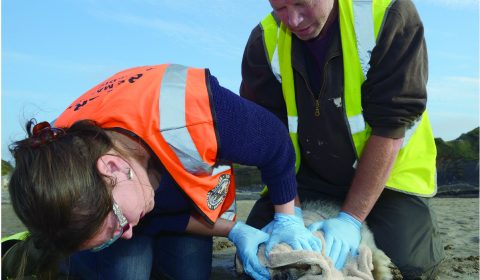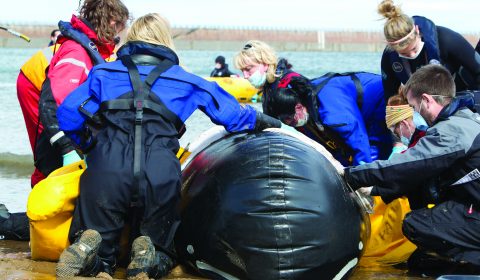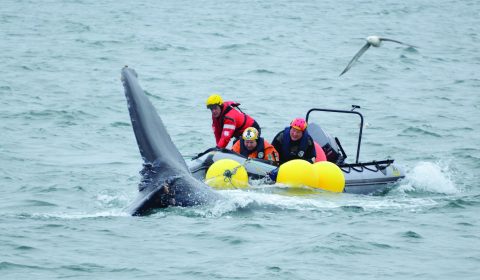Although seal rescue has remained a key component of the charity’s work, it has become progressively more involved in the response to stranded and entangled cetaceans (whales, dolphins and porpoise). BDMLR were founder members of the Marine Animal Rescue Coalition (MARC), an affiliation of organisations with an active interest and involvement in the management of marine mammal strandings in the UK, with a primary focus of improving the response to live cetacean strandings. This has been achieved through sharing information and opinions, encouraging training and equipment, and consideration of the options available for the disposition of beached animals in the context of UK strandings patterns.
Every year, BDMLR trains over 1000 volunteer Marine Mammal Medics and has over 25 whale refloatation pontoons located at strategic points throughout the UK, waiting to help stranded whales and dolphins. Medics are trained to provide them with the basic knowledge, skills and expertise to enable them to respond to a callout and act on behalf of that animal’s best welfare interests.
BDMLR is a registered charity, number 803438 in England and Wales, and SC039304 in Scotland.
Trustees
Chairman: Alan Knight OBE, BSc (Hons)
Mark Stevens BEd (Hons)
Geoff Hammock
Gavin Parsons
Faye Archell BSc (Hons) CertEd
Martin Boon
Staff
Julia Cable, Director of Operations
Dan Jarvis, Director of Welfare and Conservation
Molly Brown, Rescue and Community Coordinator
Natalie Arrow, Head Veterinary Consultant
Lewis Griffin, Rescue Coordinator
Em Mayman, Rescue Coordinator
Will Ritchie, Finance Manager
Veterinary consultants
Head Veterinary Consultant: Natalie Arrow BVetMed MVetSci MRCVS
James Barnett BSc (Hons) BVSc MRCVS
Steve Bexton BVMS MRCVS
Jon Cracknell BVMS CertVA CertZooMed. MRCVS
Jo Hedley CertZooMed MRCVS
Sean Langton BVetMed CertVA DipECVAA MAcadMEd FHEA MRCVS
Ana Rubio Garcia
Scientific consultants
Mark Simmonds OBE
Sue Sayer MBE BSc PGCE
Rob Deaville BSc
Jamie Bojko BSc PhD
Rebecca M Boys, BSc, PhD
Patrons
Doug Allan
Gordon Corrins
Kate Humble
Monty Halls
Miranda Krestovnikoff
Elizabeth Emanuel
Dr Martha Holmes
Amanda Levick
History
- 1988: BDMLR forms in response to the Phocine Distemper Virus epidemic in the North Sea, helping to reach infected seals and bringing them for rehabilitation with the RSPCA.
- 1991: BDMLR and the Born Free Foundation work together to rehabilitate and release three captive bottlenose dolphins back to the wild, in a mission called Into The Blue.
- 1992: A team travels to the Faeroe Islands and uncovers evidence of cetacean hunting, which is exposed to the world.
- 1993: A team is dispatched to Shetland to assist with the recovery of oiled wildlife casualties following the Braer shipwreck.
- 1995: responders attend the live stranding of a killer whale in Kent, moving the charity towards becoming a stranded cetacean response organisation.
- 1996: A team with a Rigid Inflatable Boat are dispatched to Pembrokeshire, Wales, to assist with the recovery of oiled wildlife casualties following the Sea Empress grounding.
- 1997: BDMLR creates and runs the first Marine Mammal Medic course held in the UK, and begins forming its national volunteer response network.
- 1999: A minke whale live stranded in Cornwall becomes the first successful rescue of a cetacean in the UK using the inflatable pontoon refloatation system developed by Project Jonah in New Zealand.
- 2002: A second PDV epidemic sweeps across the North Sea, with thousands of seals dying as a result of secondary infections. BDMLR Medics carry out coastal patrols and help bring afflicted seals to rehabilitation centres for veterinary care.
- 2003: Senior BDMLR instructors are sent to the Falkland Islands to run a Marine Mammal Medic course there to help them set up their first marine mammal response team.
- 2006: A northern bottlenose whale strands alive in central London and is watched on live television by over 500 million people as BDMLR and other agencies launch a rescue operation. The animal was later due to be put to sleep after being assessed to be in poor health, but died naturally before this could be done.
- 2006: Just a week after the Thames whale incident, a bottlenose dolphin known as ‘Marra’ had become trapped in a marina in Maryport, Cumbria, and had to be physically removed in a major operation that made national news headlines. The operation, also involving the Coastguard and RNLI, was successful.
- 2006: BDMLR’s Chairman and founder, Alan Knight, is awarded an OBE in the Queen’s Birthday Honours list in recognition for his services to animal welfare.
- 2007: BDMLR Medics help recover oiled wildlife casualties from the Napoli shipwreck in Dorset.
- 2008: The largest common dolphin mass stranding on record in the UK occurs in Cornwall. BDMLR leads a huge rescue operation with emergency services across five separate locations. 24 dolphins were already dead while 2 more had to be euthanased, however over 70 dolphins are successfully taken back out to sea.
- 2011: The first of several major pilot whale mass strandings occur across Scotland between now and 2015, after a long period without any incidents.
- 2013: BDMLR sets up the UK’s first and only specialised Large Whale Disentanglement Team to rescue entangled whales at sea, with training provided by the Center for Coastal Studies and International Fund for Animal Welfare in the USA.
- 2013: Medics from across Devon and Cornwall rescue wildlife casualties in two separate pollution incidents involving the chemical polyisobutane (PIB) on the south coast. The chemical is later banned from at-sea discharge by the International Maritime Organisation thanks to a petition set up by a BDMLR Medic.
- 2015: BDMLR and the Born Free Foundation reunite to undertake a new mission called Back To The Blue to rehabilitate and release two captive bottlenose dolphins back to the wild in Turkey.
- 2015: Members of the BDMLR Large Whale Disentanglement Team join forces with the International Fund for Animal Welfare to successfully disentangle a humpback whale in Flaxafoi Bay, Iceland.
- 2016: BDMLR embarks on a series of training sessions in Kazakhstan in conjunction with Tengizchevroil and the Institute of Hydrobiology to create a new rescue team for Caspian seals and sturgeon in the Caspian Sea.
- 2017: With funding from the Seal Protection Action Group, BDMLR designs and creates the UK’s first Mobile Seal Rescue Unit – a horse box converted and customised into a fully equipped temporary holding and treatment facility.
- 2017: Calls to the BDMLR hotline surpasses 1000 for the first time in a single year.
- 2017/18: A series of severe Atlantic storms likely exacerbated by climate change hit the coasts of South West England and Wales during autumn and winter, leading to an unprecedented number of callouts across the region that became known as the ‘seal crisis’.
- 2018: BDMLR staff member Dan Jarvis is awarded the Mandy McMath Conservation Award at the annual conference of the European Cetacean Society, becoming the youngest ever recipient as well as the first to receive it primarily for working with seals and in the field of animal welfare.
- 2019: The Government of Gibraltar’s Department for Environment, Heritage and Climate Change hosts BDMLR instructors to train their first stranded cetacean response team.
- 2020: Calls to the BDMLR hotline surpasses 2000 for the first time in a single year.
- 2021: BDMLR opens its first custom-built seal hospital in Cornwall to help cope with high influxes of seal casualties affected by storms linked with climate change and rising callout figures.
- 2021: The University of Padova, Italy, hosts BDMLR instructors to run a stranded cetacean response training course for veterinary students and members of the Cetacean Emergency Response Team.
- 2021: Storm Arwen devastates grey seal pupping sites in the north and east of the UK, with some sites losing several hundred pups overnight and a second ‘seal crisis’ in the aftermath. This helps to push calls to the hotline past 3000 in a single year for the first time.
- 2022: BDMLR extends its Marine Mammal Medic coverage to Northern Ireland to become a fully UK-wide response team.
- 2024: The largest pilot whale mass stranding in recent times occurs in Orkney, involving 77 animals. The large majoirty are already deceased and the remaining animals too deteriorated to survive.
- 2024: Calls to the BDMLR hotline surpass 4000 in a single year.
- 2025: Two of the charity’s existing seal holding units are upgraded to create the North East Seal Triage unit and Suffolk Seal Rescue Unit. The Mobile Seal Rescue Unit is retired from service.
- 2025: It is a busy year for international courses with BDMLR training groups in France, Egypt, Denmark and Cape Verde, helping to begin or contribute to response efforts in these countries.









